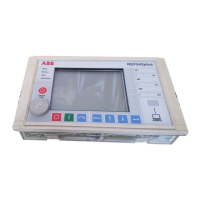Multifunction Protection and Switchgear Control unit REF542plus
Manual: Motor Protection with ATEX-Certification
With help of tables 2 and 3, the value for setting constant (k) or the root of the ex-
tended memory contents can be calculated on the basis of equation (10) if the motor
is to be run up to limit temperature.
In the following example, it is assumed that the motor winding is of thermal class F
and of temperature class T1. The environment temperature is according to [DIN3] to
be set to 40°C. In accordance with table 2, the rated motor temperature is 130°C and,
in accordance with table 3, the limit temperature for the generation of the tripping sig-
nal is 210°C. Therefore the setting constant is
27,1
40130
40210
uMn
ut
=
−
−
=
−
−
=
ϑϑ
ϑϑ
k
(12.)
According to the standard the k-value shall be in the range of 1.0 to 1.2. This means,
that the thermal memory content should be set in the range of 100 to 144%.
In this example, the tripping is not supposed to occur at a limit temperature of 210 °C.
So a smaller setting constant k has to be chosen. For this example, the setting con-
stant k shall be set to 1.1. This will limit the increase of the memory contents to 121%.
Based on equation (10), the tripping temperature can be calculated: (1.21x90) °C +
40°C = 149°C. It is now possible to calculate the tripping time with the equation be-
low:
uMn
uTRIP
2
Mn
uMn
up
2
Mn
ln
ϑϑ
ϑϑ
ϑϑ
ϑϑ
τ
−
−
−
⎟
⎟
⎠
⎞
⎜
⎜
⎝
⎛
−
−
−
⎟
⎟
⎠
⎞
⎜
⎜
⎝
⎛
=
I
I
I
I
t
(13.)
In this case, I is the instantaneous on-load current, IMn is the nominal motor current,
ϑ
p
the temperature due to an assumed specific preloading, ϑ
env
is the environment
temperature, ϑ
Mn
is the nominal motor temperature, and ϑ
TRIP
is the temperature
causing tripping.
When the auxiliary voltage is switched on for the first time, the thermal replica will be-
gin to operate with a specified memory content which is determined by the setting for
T ini. This memory contents defined the preloading at this switching on momentary. It
is to be recommended to choose the setting for the warm condition of the motor within
a range of 80 ... 100% of the memory contents. For instance, with a setting of 90%
memory contents it is necessary firstly to determine the entire memory contents on
the basis of temperature settings TMn and Tenv.
Based on the above example, the thermal capacity is proportional to the temperature
difference of
C90C04-C130 °
°°
In accordance with the above example, a thermal capacity preloading has to be set to
0.9 or 90%. As a result, the setting has to be
C121C)0,9(90C40ini °
°+°=T
If the auxiliary voltage is shut down, the instantaneous motor temperature is provided,
in that particular moment, with the absolute time of the built-in real-time clock and
saved in a non-volatile memory. Provided that the motor remains off during the failure
of the auxiliary voltage, a cooling-off of the motor is assumed with a time constant
TCOff. When the auxiliary voltage is recovered again, the entire outage time of the
auxiliary voltage will be determined based on the stored time data. It may be as-
1VTA100114-Rev. 04 en PTMV, 19.01.05 Motorprotection 23 / 66
Valid from Version V4D02

